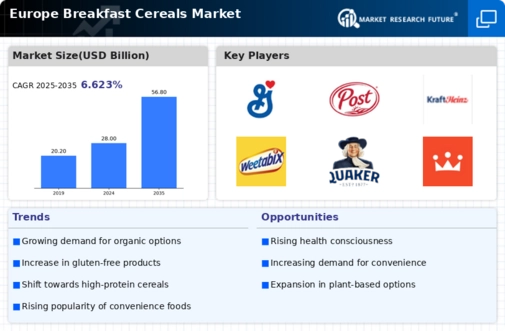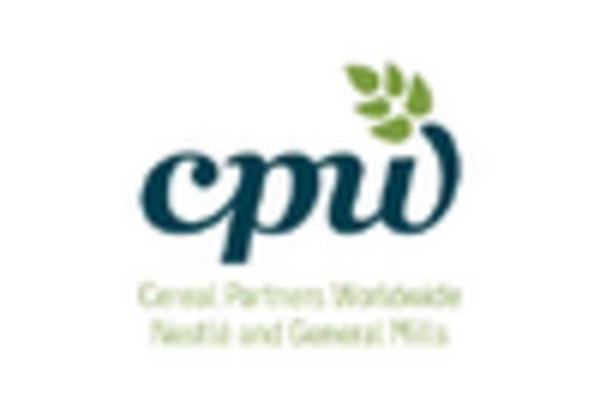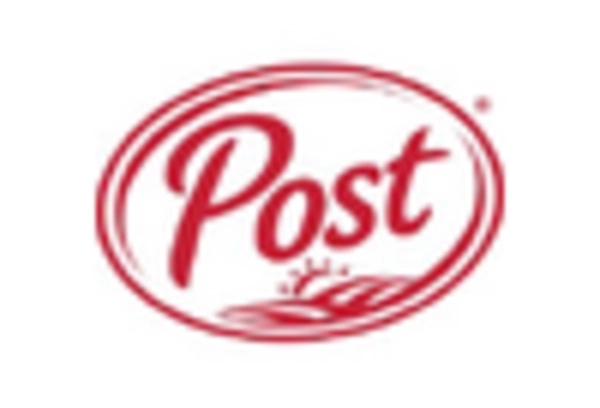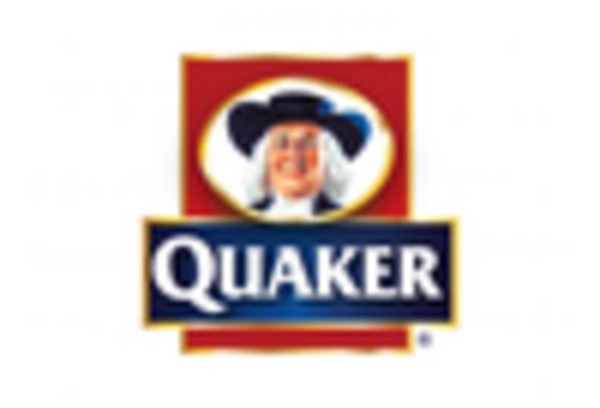Rising Health Consciousness
The increasing awareness of health and nutrition among consumers is a pivotal driver in the breakfast cereals market. As individuals prioritize healthier lifestyles, they gravitate towards cereals that offer whole grains, low sugar content, and added nutrients. In Europe, the demand for organic and natural ingredients has surged, with a reported growth of 15% in organic breakfast cereals in the last year. This trend indicates a shift towards products that align with health-conscious choices, compelling manufacturers to innovate and reformulate their offerings. The breakfast cereals market is thus witnessing a transformation, where brands are investing in research to develop healthier options that cater to this growing demographic. This focus on health not only influences purchasing decisions but also shapes marketing strategies, as companies highlight the nutritional benefits of their products to attract discerning consumers.
Convenience and Busy Lifestyles
The fast-paced lifestyle of modern consumers significantly influences the breakfast cereals market. With an increasing number of individuals leading busy lives, the demand for convenient breakfast options has escalated. Ready-to-eat cereals, which require minimal preparation, are particularly appealing to working professionals and families. In Europe, approximately 60% of consumers report that convenience is a key factor in their breakfast choices. This trend has prompted manufacturers to develop single-serve packaging and on-the-go options, catering to the needs of consumers who seek quick yet nutritious meals. The breakfast cereals market is adapting to these demands by introducing innovative packaging solutions that enhance portability and ease of use. As a result, brands that successfully combine convenience with quality are likely to gain a competitive edge in this evolving market landscape.
Technological Advancements in Production
Technological advancements are playing a transformative role in the breakfast cereals market, enhancing production efficiency and product quality. Innovations in processing techniques, such as extrusion and fortification, allow manufacturers to create cereals that are not only nutritious but also appealing in texture and taste. Furthermore, advancements in data analytics enable companies to better understand consumer preferences and optimize their product offerings accordingly. In Europe, the integration of technology in production processes has led to a reported 20% reduction in waste, contributing to more sustainable practices. As manufacturers continue to invest in technology, the breakfast cereals market is likely to see an increase in the availability of high-quality, innovative products that meet the demands of health-conscious consumers while maintaining competitive pricing.
Diverse Flavor Profiles and Customization
The demand for diverse flavor profiles and customization options is reshaping the breakfast cereals market. As consumers seek unique and exciting taste experiences, brands are expanding their product lines to include a variety of flavors, from exotic fruits to indulgent desserts. This trend is particularly pronounced among younger demographics, who are more adventurous in their food choices. In Europe, the introduction of limited-edition flavors and seasonal offerings has proven successful, with some brands reporting a 25% increase in sales during promotional periods. Additionally, customization options, such as mix-and-match cereals or personalized blends, are gaining traction. This shift towards flavor diversity and personalization not only caters to evolving consumer preferences but also encourages brand experimentation, fostering a dynamic and competitive landscape within the breakfast cereals market.
Sustainability and Eco-Friendly Practices
Sustainability has emerged as a crucial driver in the breakfast cereals market, reflecting a broader societal shift towards environmentally responsible consumption. European consumers are increasingly concerned about the ecological impact of their food choices, leading to a growing preference for brands that adopt sustainable practices. This includes sourcing ingredients from responsible suppliers, utilizing eco-friendly packaging, and minimizing carbon footprints. Recent studies indicate that 70% of consumers in Europe are willing to pay a premium for products that are sustainably produced. Consequently, manufacturers are re-evaluating their supply chains and production methods to align with these consumer values. The breakfast cereals market is thus witnessing a rise in brands that emphasize their commitment to sustainability, which not only enhances brand loyalty but also attracts environmentally conscious consumers.


















Leave a Comment